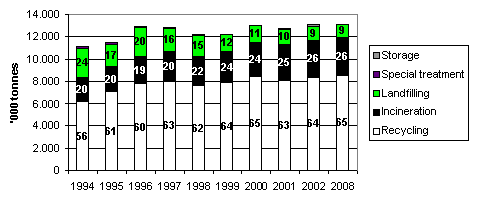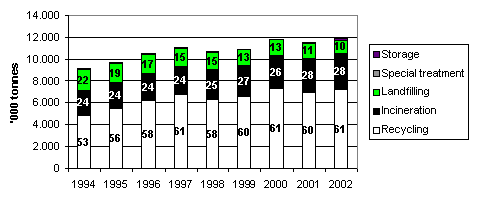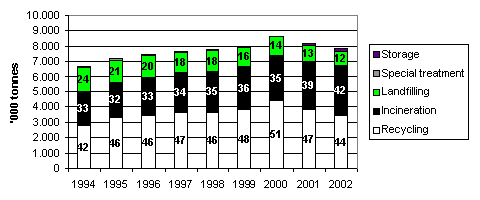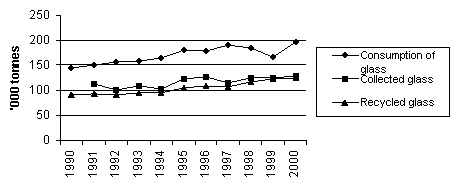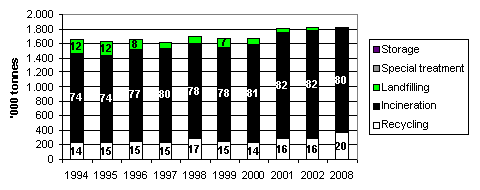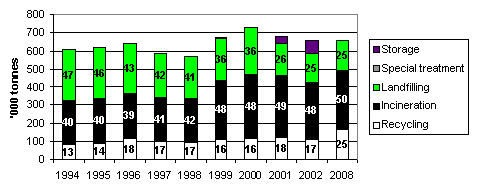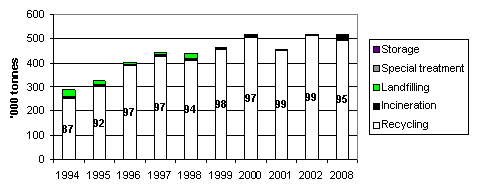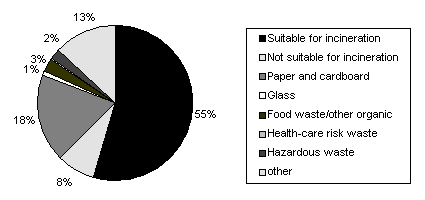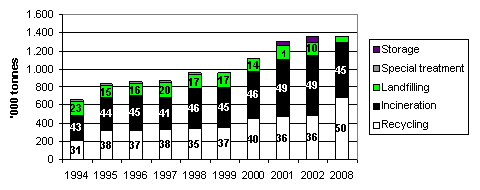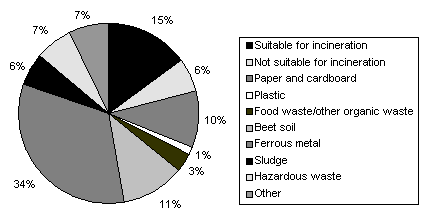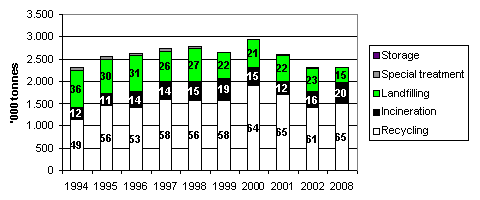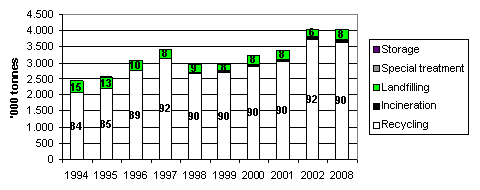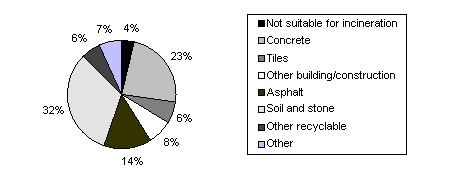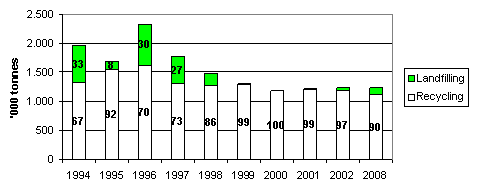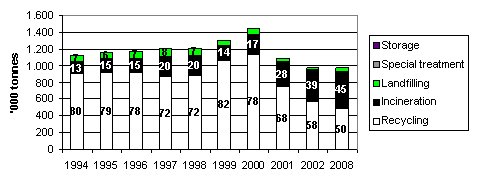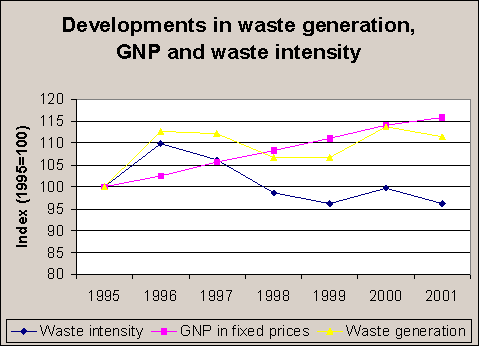|
Environmental Review no. 2, 2004 Waste Statistics 20021 Waste generation and treatment
4 Imports and exports of waste
5 Individual waste sources and status in relation to targets for 2008
6 Incineration plants and landfills 7 New indicators for resource loss and environmental impacts
8 Projection of waste generation
Annex 1 Tables of waste generation Annex 2. Principles for distribution of waste received at recycling centres and transfer stations Annex 3 Treatment of hazardous waste PrefaceThe ISAG (Information System for Waste and Recycling) The ISAG was used for the first time in 1993. This is the tenth consecutive year that data on waste and recycling has been reported to the ISAG. The ISAG is based on statutory registration and reporting from Danish waste treatment plants for all waste entering or leaving the plants. Information concerning waste in the previous year must be reported to the Danish Environmental Protection Agency (Danish EPA) each year, no later than 31 January. In order to avoid double registration, it is important to distinguish between waste from direct (primary) sources and waste from plant (secondary) sources. The principles behind registration in the ISAG are shown below.
The Danish EPA carries out quality assurance of the information it receives and collects additional information from sector organisations and other sources. Each year the Danish EPA prepares a publication called Waste Statistics, which gives an overview of waste composition and waste arisings in Denmark. The publication also provides an outline of how much of the total amount of waste has been recycled, incinerated and landfilled. Information is analysed between commercial sources and waste types. New methods Since 2001 data have been reported according to the new rules set out in the Statutory Order on Waste (Statutory Order No. 619 of 27 June 2000). The new rules have meant a number of changes to the ISAG. Amongst other things, the source "manufacturing etc." no longer exists, so that from 2001 industrial waste can only be analysed between 11 different sectors. At the same time, packaging waste has been added as a new waste type. Industry experienced a fall in waste arisings of 11 per cent from 2000 to 2001; while the service sector saw a 17 per cent rise in waste generation. The shift between the two sectors may be due to faulty registration, as the source "Manufacturing etc." was discontinued from 2001 as a result of amendments to the Statutory Order on Waste. [1]. This means that waste from industry must be registered as originating from one of the 11 subgroups: food, beverages and tobacco; textiles, clothing and leather goods; wood-working and furniture; paper and graphical production; chemicals etc.; rubber and plastic; stone-working, pottery and glass; ferrous metals; other manufacturing; utilities; agriculture, forestry, fishery etc. It is likely that some carriers find it easier to register industry waste as service-sector waste. Incineration plants and landfills reporting to the ISAG are therefore encouraged to be aware of this possible source of incorrect registration. Throughout 2003 a number of training courses will be held for those reporting to the ISAG in order to e.g. clarify registration procedures. Changes in the industrial structure - the fact that society is changing from an industrial to a knowledge society - may be another reason for the shift between the two sectors. Whether the shifts between the two sectors are due to this development will be examined more closely before the publication of Waste Statistics 2003. Packaging waste is a new waste type in the ISAG and does not yet reflect the total amount of packaging waste in the form of cardboard and plastic collected for recycling in Denmark. Incineration plants and landfills reporting to the ISAG are therefore encouraged to be aware of this possible category of waste. The principles for categorising the waste fractions glass, and paper & cardboard received from recycling centres/transfer stations have likewise been changed compared to the years 1994 to 2000. See Annex 2 for a more detailed explanation of the principles for the recategorisation. From 2001, sludge for mineralisation has been included with a dry matter content of 20 per cent. Thus sludge that is mineralised is incorporated into the statistics with the same dry matter content as the remaining sludge. In previous years dry matter content for sludge for mineralisation has been 1.5 per cent. Please note that the changes mentioned above in reporting data since 2001, mean that care should be taken when comparing waste arisings at sector level from 2001 and later with waste arisings from previous years. The government's Waste Strategy 2005-2008 presents a shift in focus - from using exclusively waste arisings as an indicator for target fulfilment to also using new waste indicators for resource loss and environmental impacts. Reading guide Waste Statistics 2002 includes an additional chapter on the new waste indicators. Apart from this new chapter, Waste Statistics 2002 follows the same structure as previous Waste Statistics: Chapter 1 describes the general trends in waste generation, while Chapter 2 deals with recycling of waste. Chapter 3 deals with generation and treatment of hazardous waste, and in Chapter 4 developments in imports and exports are described, both for ordinary waste and waste subject to mandatory notification. In Chapter 5, a description of developments in waste arisings and treatment of waste from different sources is given. Furthermore, the level of achievement of targets for treatment in the Danish government's Waste Strategy 2005-2008 is assessed. Chapter 6 presents the latest figures for the number of Danish incineration plants and landfills. Chapter 7 is about the new waste indicators and in Chapter 8 a baseline projection of developments in waste arisings until 2020 is given. Summary and conclusionsReports to the ISAG for 2002 cover 407 plants owned by 296 enterprises. In 2001, reports covered 402 plants owned by 295 enterprises. Waste generation in 2002 is compared to targets from 2008 in the government's Waste Strategy 2005-2008. The following statements summarise waste generation in 2002:
1 Waste generation and treatment1.1 Waste generation 2002 and developments 2001-2002Waste generation in 2002 and developments in waste arisings from 2001 to 2002 are presented in Table 1. In 2002, Danish waste generation amounted to 13,105,000 tonnes. This corresponds to an increase of 3 per cent from the 2001 figure. Most of this increase stems from a 19 per cent increase in construction and demolition waste compared to 2001. This increase is for the most part due to a 636,000 tonnes increase in amounts of soil and stone because of the new plants reporting to the ISAG. The new reporters to the ISAG are 8 soil treatment plants, out of which only one plant reported about 45,000 tonnes soil and stone in 2001. This means that waste generation has fallen by 2 per cent compared to 2001. In addition, there has been an increase in amounts of waste from the service sector of 4 per cent [2] compared to the year before. Waste from households amounted to 3,121,000 tonnes in 2002. This means that waste generation has increased by 1 per cent compared to 2001. The five waste types under household waste show both decreases and increases. Domestic waste amounts remain almost unchanged from the previous year. As Table 1 shows, domestic waste arisings have increased by 2 per cent during the period 1994 – 2000, showing only very slight changes from year to year [3]. There has been a reduction in amounts of bulky waste of 4 per cent or 25,000 tonnes compared to 2001. Waste registered as "other" has fallen by 5 per cent - a total amount of 7,000 tonnes. Increases are apparent for the waste types garden waste and packaging waste, which have increased by 13 per cent and 10 per cent respectively or 59,000 tonnes and 10,000 tonnes. Amounts of separated packaging waste were reported to the ISAG for the first time in 2001. The total amount of packaging waste reported to the ISAG in 2002 is 200,933 tonnes. Of this amount, 117,000 tonnes have been registered as domestic waste generated by households in 2002. According to the Danish EPA packaging statistics [4] total packaging materials collected for recycling in Denmark amounted to 324,000 tonnes. The difference could be due to faulty registration in the ISAG, as the waste type packaging waste is new to the ISAG since 2001. Thus, there may be uncertainty as to whether the waste is to be registered as packaging waste or as another waste type. The generation of waste in the service sector amounted to 1,357,000 tonnes in 2002, which is 4 per cent more than in 2001 – in actual figures an increase of 50,000 tonnes. The increase is apparent in the following fractions: waste suitable for incineration, paper and cardboard, glass, and other. These fractions have increased by 9 per cent, 2 per cent, 2 per cent, and 13 per cent respectively compared to 2001. The fractions: waste not suitable for incineration, food waste/other organic waste, healthcare risk waste, and hazardous waste show reductions of 16 per cent, 18 per cent, 7 per cent, and 26 per cent respectively. The amounts of waste from industry [5] have fallen. For this source, amounts have fallen from 2,616,000 tonnes in 2001 to 2,311,000 tonnes in 2002 - a decrease of 305,000 tonnes, or 12 per cent. The fall is primarily due to reductions in the fractions: waste not suitable for incineration, paper and cardboard, food waste/other organic waste, ferrous metals, hazardous waste, and other. These fractions fell by 15 per cent, 15 per cent, 35 per cent, 18 per cent, 6 per cent, and 25 per cent respectively. In contrast, the fractions: waste suitable for incineration, plastic, and sludge have shown an increase of 3 per cent, 3 per cent, and 23 per cent per cent respectively. Industry experienced a fall in waste arisings of 11 per cent from 2000 to 2001; while the service sector saw a 17 per cent rise in waste generation. The shift between the two sectors may be due to faulty registration, as the source manufacturing etc. was discontinued from 2001 as a result of amendments to the Statutory Order on Waste. [6]. This means that waste from industry must be registered as originating from one of the 11 subgroups: food, beverages and tobacco; textiles, clothing and leather goods; wood-working and furniture; paper and graphical production; chemicals etc.; rubber and plastic; stone-working, pottery and glass; ferrous metals; other manufacturing; utilities; agriculture, forestry, fishery etc. It is likely that some carriers find it easier to register industry waste as service-sector waste. Incineration plants and landfills reporting to the ISAG are therefore encouraged to be aware of this possible source of incorrect registration. Throughout 2003 a number of training courses will be held for those reporting to the ISAG in order to e.g. clarify registration procedures. Changes in the industrial structure - the fact that society is changing from an industrial to a knowledge society - may be another reason for the shift between the two sectors. Whether the shift between the two sectors is due to this development will be examined more closely before the publication of Waste Statistics 2003. Generation of waste in the building and construction sector was larger in 2002 than in 2001 – construction and demolition waste thus reached 4,044,000 tonnes, which is 653,000 tonnes or 19 per cent more than in 2001. The increase is apparent in the fractions: soil and stone, and asphalt. These fractions increased by 111 per cent and 59 per cent respectively. In 2002, 693,000 more tonnes of soil and stone were registered. This increase is due to the fact that soil treatment plants have been added as reporters to the ISAG with the amendment of the Danish Statutory Order on Waste. In 2002, 8 soil treatment plants reported around 636,000 tonnes of soil and stone to the ISAG. Only one of the plants reported around 45,000 tonnes of soil and stone in 2001, and a large crushing plant previously and incorrectly registered a large part of its crushed waste as originating from secondary sources. This means that amounts have not been included in the statistics, since this would result in double registration. These waste amounts are now being registered correctly as originating from primary sources, which leads to an increase of 167,000 tonnes in total waste amounts from building and construction - an increase, which does not reflect an actual growth in waste arisings. By far the major part, or 92 per cent, of waste generated by the building and construction sector is recycled. There has been a 10 per cent reduction in amounts of sludge from municipal wastewater treatment plants: sludge amounted to 1,011,000 tonnes in 2002 [7], calculated at a dry matter content of 20 per cent. This is 112,000 tonnes less than in 2001. From 2001, sludge for mineralisation has been included with a dry matter content of 20 per cent. Thus sludge that is mineralised is incorporated into the statistics with the same dry matter content as the remaining sludge. In previous years dry matter content for sludge for mineralisation has been 1.5 per cent. Waste generation at coal-fired power plants increased by 1 per cent, which is an increase from 1,211,000 tonnes in 2001 to 1,228,000 tonnes in 2002. This is due to the fact that energy generation was larger in 2002 than in 2001. Denmark had net exports of electricity in 2002. During the period 1995-2000, waste arisings from coal-fired power plants fell. For the first time in this period Denmark had net imports of electricity in 2000. Another significant reason for the decrease in residues from coal-fired power plants is that energy is increasingly generated from other fuels than coal and coke [8]. 1.2 Treatment of waste in 2002In the following, developments in treatment of total waste arisings are presented. Waste treatment is compared to treatment targets in the Danish government's Waste Strategy 2005-2008. Table 2 shows that 8,382,000 tonnes, corresponding to 64 per cent of total waste arisings, were recycled in 2002. In actual figures this is an increase of 281,000 tonnes or an increase of 3 per cent compared to 2001. Waste incinerated in 2002 amounted to 3,344,000 tonnes. This is actually a 123,000 tonnes increase in amounts compared to the previous year, which as a proportion of total waste arisings is 26 per cent. Waste led to landfill in 2002 amounted to 1,194,000 tonnes, which is a decrease of 123,000 tonnes from 2001. The rate of landfilled waste amounts to 9 per cent of total arisings. The percentage proportion of waste led to landfill has fallen by 15 percentage points in the period 1994 to 2002, corresponding to a reduction in landfilled waste arisings of 1,419,000 tonnes. As the table shows, the relative distribution in recent years among treatment options has varied only little. Variations are often explained by developments in amounts of the different fractions. For example, variations in amounts of residues from coal-fired power plants and construction and demolition waste have large implications on the total rate of recycling, as these two waste types account for a large percentage of total waste arisings and typically have a rate of recycling of 90 per cent or more. In the Danish government's Waste Strategy 2005-2008 the target of stabilising Danish waste generation is supplemented by a number of qualitative elements such as better exploitation of resources in waste, better quality in treatment of waste, and limitation of problems caused by environmental contaminants in waste. In general, targets for different sectors and individual fractions will mean an increased rate of recycling and incineration. Overall waste treatment targets for 2008 in the government's Waste Strategy 2005-2008 are 65 per cent recycling, 26 per cent incineration, and a maximum of 9 per cent landfilling. As can be seen from Figure 1, the overall targets for treatment of waste in 2008 have almost been met in 2002. In 2002, one per cent of total waste arisings has been registered under the treatment option storage. Storage means temporary landfilling of waste suitable for incineration until incineration capacity is available. The recycling rate is one percentage point from the 2008 target, whereas the incineration rate has been surpassed by one percentage point, and the target for landfilling has been met. This is believed to be attributable to the ban on landfilling of waste suitable for incineration that came into effect on 1 January 1997. However, other factors play a role. Figure 1. Treatment of waste in Denmark 1994-2002 and targets for 2008
Source: Same as Table 1. Note that total waste arisings in 2008 have been set to correspond to waste arisings in 2002. The figure is not intended as a projection of developments in total waste arisings. First of all, amounts of residues from coal-fired power plants have decreased significantly, and they are furthermore recycled to a larger extent than in previous years when they were mainly landfilled. 1.3 Treatment of waste WITHOUT residues and construction and demolition wasteAmounts of residues from coal-fired power plants not only depend on energy consumption in Denmark, but also on exports of electricity to Sweden and Norway. In addition, due to Energy 21 a still larger shift is taking place from use of coal and coke as fuel to use of natural gas and renewable energy. Since 1996, when Denmark's electricity exports to Sweden and Norway were particularly large, amounts of residues have decreased steadily up until 2000. In actual figures this is a 1,156,000-tonne decrease, corresponding to almost a 50 per cent reduction. Naturally, this has an impact on developments of total waste arisings, but as residues have a very high rate of recycling, it also has an impact on being able to meet overall treatment targets. A similar picture is seen for construction and demolition waste. As discussed in section 6.4, the rate of recycling of construction and demolition waste typically reaches around 90 per cent. Therefore, it is interesting to look at the distribution of waste between the different treatment options, if residues and construction and demolition waste are excluded from statistics. Figure 2 shows the distribution between the different treatment options when residues from coal-fired power plants are excluded from statistics. Figure 2. Treatment of waste in Denmark 1994-2002 WITHOUT slag, fly ash etc. (coal)
Source: same as Table 1. When residues are excluded it is seen that 61 per cent of the remaining waste was recycled in 2002, which is an increase of 293,000 tonnes from 2001. The rate of remaining waste incinerated in 2002 is 28 per cent, which is to say that 123,000 tonnes more waste were incinerated in 2002 than in the year before. The rate of waste for landfilling is 10 per cent, which is a 151,000 tonne reduction compared to 2001. In actual figures this means that in 2002, apart from residues, 11,877,000 tonnes of waste were generated, corresponding to an increase of 3 per cent from 2001. Of these, 7,192,000 tonnes were recycled, whereas 3,344,000 tonnes were incinerated, and 1,156,000 tonnes were landfilled. Moreover, 22,000 tonnes were given special treatment and 163,000 tonnes have been temporarily landfilled until incineration capacity becomes available [9]. Total waste amounts without waste from coal-fired power plants increased by 30 per cent from 1994 to 2002. In Figure 3 waste from the building and construction sector has also been excluded from statistics. This causes a decrease in the rate of remaining waste for recycling, whereas the rates for incineration and landfilling increase. In actual figures, waste generation without residues and without waste from construction and demolition amounted to 7,833,000 tonnes in 2002, which is 333,000 tonnes, or 4 per cent, less than in 2001. In other words, if residues and waste from building and construction are excluded, there has been a fall in total waste arisings. Residues from coal-fired power plants and construction and demolition waste are recycled to a very large extent: in 2002, 97 per cent and 92 per cent respectively, cf. Chapter 6. It is seen that these two fractions play a very significant role in the compliance with overall waste treatment targets in the Danish government's Waste Strategy 2005-2008. Figure 3. Treatment of waste in Denmark 1994-2002 WITHOUT slag, fly ash etc. (coal) and WITHOUT construction and demolition waste
Source: same as Table 1. 1.4 Treatment by sources and waste typesFigure 4 shows total waste generation in 2002 analysed by sources and treatment options. Figure 5 shows waste generation by waste types and treatment options. Tables with detailed figures are given in Annex 1. Figure 4 shows that waste from the building and construction sector, power plants and wastewater treatment plants reached a very high rate of recycling. Targets for recycling in the Waste Strategy 2005-2008 have thus been met for waste generated by these three sectors. The rate of recycling of waste from industry is also relatively high: 61 per cent compared to a target of 65 per cent recycling. The high rate of recycling, however, is especially attributable to recycling ferrous metals. Still too much waste from this sector is led to landfill - 23 per cent against the target of only 15 per cent, and there is a challenge ahead to divert larger amounts of the other fractions from landfilling to incineration or recycling. The rate of recycling of waste from the service sector is likewise too low compared to the 2008 target of 50 per cent recycling. In 2002, only 36 per cent of the waste was recycled. The target of 45 per cent incineration has not been met, as 49 per cent is incinerated and 5 per cent is in temporary storage pending incineration when capacity becomes available. Too much waste is landfilled: 10 per cent against the target of 5 per cent. The challenge for the service sector is to divert more waste from landfilling and incineration to recycling. Treatment of the waste type domestic waste does not comply with the targets in the Waste Strategy 2005-2008, cf. Figure 5. Only 16 per cent of this waste was recycled in 2002. The recycling rate for the period 1994-2002 has fluctuated between 14 per cent and 17 per cent. The target is to reach a recycling rate of 20 per cent in 2008, whereas the targets for incineration and landfilling are 80 per cent and 0 per cent respectively. The rate of domestic waste incinerated in 2002 reached 82 per cent, whereas 2 per cent was led to landfill [10]. 1.5 Developments in waste generation 1994-2002Table 3 shows total waste arisings in Denmark for the years 1994-2002. Waste generation is analysed by commercial sources. There was an 18 per cent increase in total waste arisings in the period 1994-2002. Waste generation was largest in 2002. The reduction in waste arisings in 2001 should be seen in context with the changes in methods of calculation applied. There was an increase of 16 per cent in amounts of waste from 1994 to 1996, after which amounts decreased up to 1999 by approximately 5 per cent. From 1999 to 2000 waste arisings increased by 7 per cent. From 2000 to 2001 waste arisings fell 2 per cent. The increase in the first half of the 1990s may be due partly to the fact that coverage of the ISAG system has increased and partly due to real increases in waste amounts. The large amounts in 1996 were primarily due to particularly high amounts of residues from coal-fired power plants in 1996 – which again was due to large exports of electricity to Sweden and Norway. 2 Recycling2.1 Recycling analysed by fractionsTable 4 shows the proportion of the different waste fractions that are separated for recycling in the form of reprocessing, composting, or biogasification. The table is not an outline of total amounts generated of each fraction. As the table shows, 8,357,000 tonnes of waste were recycled in 2002, which is 3 per cent or 256,000 tonnes more than in 2001. This increase is attributable to a steep increase in recycling of branches, leaves and grass, asphalt, and soil and stone, as well as to a decrease in the rate of recycling of almost all other fractions. 2.2 Paper and cardboardConsumption of virgin paper and the rate of collection of waste paper in the period from 1994 to 2002 are shown in Table 5. Note that statements of virgin paper consumption for 2001 and 2002 are not yet available. [11] Total collected waste paper in 2002 amounted to 688,000 tonnes. This is a decrease of 23,000 tonnes, or 3 per cent, from total amounts collected in 2001. Table 6 shows collected paper analysed by source and by the waste type packaging waste and remaining waste types. Not surprisingly, the largest amounts of waste paper are collected from households, the service sector, and industry. The largest amount of packaging waste originates from the service sector. Packaging waste is a new waste type in the ISAG and it does not yet reflect the total amount of packaging waste in the form of cardboard collected for recycling in Denmark. In 2000, 295,000 tonnes of packaging waste consisting of paper and cardboard were recycled in Denmark [12]. Amounts of waste paper collected from households increased by around 12,200 tonnes from 2001 to 2002. Since 1997 and until 2000, amounts of paper collected from households have remained stable at around 180,000 tonnes [13]. From 2001 amounts increased to around 204,000 in 2002. Amounts of waste paper collected from the service sector increased by around 5,000 tonnes or 2 per cent, amounting to 250,300 tonnes in 2002. The amount of paper collected from industry has fallen by around 39,500 tonnes, corresponding to 15 per cent compared to 2001. In the ISAG, waste delivered to a recycling centre is registered with the commercial source "recycling centre/transfer station". Thus, it is not stated whether waste originated from households or other primary sources. From 2001 recycling centres/transfer stations must indicate a distribution scale for waste types and primary source. Since this is not yet routine, the ISAG secretariat has carried out a reallocation as shown in Annex 2. 2.3 PlasticTable 7 shows the amounts of plastic collected for recycling registered in the ISAG. In 2002 collected plastic amounted to 50,600 tonnes, which is an increase of around 4,500 tonnes from 2001. However, it is assumed that some plastic has been collected and exported directly for recycling abroad without having been registered at a Danish treatment plant. It is therefore probable that larger amounts have been collected for recycling in Denmark than the 50,623 tonnes. The fraction "plastic" covers both production waste, plastic packaging waste, and other plastic waste, with individual figures shown in Table 7. Packaging waste is a new waste type in the ISAG and it does not yet reflect the total amount of waste plastic packaging collected for recycling and reprocessing in Denmark. Thus, in the following description of recycling plastic, the ISAG figures have been supplemented with information from more detailed statistics on waste plastic packaging. Statistics on waste plastic packaging from 2000 [14] show that in that year 22,750 tonnes of waste plastic packaging were reprocessed in Denmark. Half of this amount was imported. In 2000, 19,650 tonnes of waste plastic packaging were collected in Denmark. Of this amount, 8,200 tonnes were exported for recycling abroad. Total amounts collected correspond to 12.5 per cent of total Danish consumption of plastic packaging. This is a slight increase from 1999, when 11 per cent of waste plastic packaging was collected for recycling. Waste plastic of the type polyethylene (PE) accounted for 80 per cent of collected amounts. 2.4 Bottles and glassAccording to the ISAG reports, 135,000 tonnes of bottles and glass were collected for recycling in Denmark in 2002. This is 17,000 tonnes less than in 2001. There is no explanation for this decrease. As seen in Table 8, the amount of glass collected for recycling has increased by 25,500 tonnes or 23 per cent in the period 1994 to 2002. However, the figures fluctuate somewhat throughout the period. It is evident from Table 8 that by far the major part of the collected glass is packaging waste: thus, packaging waste accounted for 87 per cent of the total amount of glass in 2002. However, the ISAG does not provide a complete picture of total material flows. This is especially the case with recycling of bottles and glass - a process with several collection, reuse, and treatment steps before glass becomes waste. As a consequence, in the following description of total recycling of glass, the ISAG information is supplemented with information from the Statistics on Glass Packaging 2000 [15], cf. Figure 6. Figure 6. Developments in consumption, collection and recycling of bottels and glass 1990-2000.
Source: Statistics on Glass Packaging 2000, Ole Kaysen, Econet. Environmental Project No. 697, 2002. Note that total consumption for 1999 has been adjusted compared with figures in the Statistics on Glass Packaging 1999. The adjustment is due to a write up of amounts of glass packaging for food preserves. Apart from minor fluctuations, consumption of glass packaging has been on the increase throughout the 1990s. Also collection and recycling of glass packaging has been increasing. Collected glass amounted to 126,000 tonnes in 1999 and 129, 000 tonnes in 2000. Amounts of recycled glass also increased - from 123,000 tonnes in 1999 to 125,000 tonnes in 2000. This means that the rate of collection of total consumption in 2000 reached 66 per cent – an increase of 3 percentage points compared to 1999. The rate of recycling of total consumption in 2000 reached 64 per cent, which is a somewhat lower rate than in 1999. Bottles for beer and soft drinks manufactured for reuse are not included in this statement. Refillable glass bottles, on average, make 30 trips. If these bottles were manufactured as single-use bottles, it would give an increase in waste glass of around 310,000 tonnes. 2.5 Ferrous metalsTable 9 shows amounts of ferrous scrap collected analysed between consignees. For 2002, it is seen that 718,000 tonnes of ferrous scrap were recycled, and this is a significant decrease of 153,000 tonnes or 18 per cent compared to 2001. Table 9 shows that the amount of ferrous scrap generated in Denmark and led to foundries and the Danish Steel Works has fallen by 191,000 tonnes or 51 per cent compared to 2001. The fall is due to the fact that the Danish Steel Works was in operation only during the first half of 2001. At the same time, there has been a fall of 122,000 tonnes, corresponding to 51 per cent, in the amounts of ferrous scrap imported by foundries and the Danish Steel Works. The Association of Danish Recycling Industries has reported that ferrous scrap not sent to the Danish Steel Works has been exported. Total potential of ferrous scrap is not known precisely. The Association of Danish Recycling Industries normally estimates a recycling rate in excess of 90 per cent for ferrous scrap. According to the ISAG reports, the Danish Steel Works and other Danish foundries imported 116,000 tonnes of ferrous scrap in 2002, whereas scrap dealers imported around 76,000 tonnes. Total imports in 2002 thus amounted to 192,000 tonnes of ferrous scrap, which is 81,000 tonnes, or 30 per cent, less than in 2001. Scrap dealers exported 611,000 tonnes of ferrous scrap in 2002, which means that net exports in 2002 were 535,000 tonnes - an increase of 8 per cent from 2001. 2.6 Organic waste for composting, wood chipping and biogasificationAmounts of organic waste led to reprocessing in the form of composting, wood chipping, biogasification, or fodder production are shown in Table 10. Organic waste led to reprocessing in 2002 amounted to 1,284,000 tonnes. This is 168,000 tonnes more than in 2001. This increase is particularly attributable to an increase in amounts of sludge for composting: 137,000 tonnes more in 2001 than in 2002, but also to an increase of 55,000 tonnes in amounts of garden waste for composting/wood chipping. Amounts of bark/wood chips and compost removed from treatment plants do not reflect the total amount generated at the plants. Rather, the amounts removed indicate the quantity sold or delivered free from the plants. It is seen from the table that amounts of sold/removed bark/wood chips were about 1,000 tonnes larger than in 2001, whereas amounts of sold/removed compost were 12,000 tonnes larger than in 2001. 2.7 TyresIn 1995, the Minister for Environment and Energy entered an agreement with a number of organisations, on a take-back scheme for waste tyres from cars, vans, and motorcycles. The purpose of the agreement is to ensure collection and recycling of waste tyres in Denmark. Landfilling is avoided and resource recovery ensured, whereby material recovery is prioritised to energy recovery. The scheme started 1 April 1995 and is financed by a fee on the tyres covered by the agreement and marketed in Denmark. According to the agreement, the target is a take-back rate of at least 80 per cent. As per 1 April 2000 the scheme was extended to cover tyres for all types of motor vehicles. Therefore, there is a leap in data from 1999 to 2000 in Table 11. The table shows that the collection rate for waste tyres surpassed 100 per cent in 2002. According to reports from the Danish Tyre Trade Environmental Foundation, this is presumably due to the fact that waste tyres have been imported from Germany, and due to the fact that some waste tyres have been collected and stored for several years. 3 Hazardous wasteTable 12 shows treatment of hazardous waste in 2001 and 2002 by main groups. The statement covers waste from both primary and secondary sources. A more detailed statement of hazardous waste analysed by the ISAG fractions is in Annex 3. Table 12 has been changed somewhat from previous years to make it more comprehensible. This means that certain fractions are now only found in Annex 3. Waste from secondary sources, such as waste from incineration plants, is not included in total waste generation, cf. Table 1. This is due to the fact that waste would otherwise be counted in statistics twice: the first time upon receipt at the primary treatment plant and the second time as a residue. However, it is reasonable to include waste from both primary and secondary sources in the assessment of capacity needs for management of hazardous waste. The total amount of waste in 2001 has been erroneously stated as 347.301 tonnes in Waste Statistics 2001. The table shows that hazardous waste from primary sources amounted to 247,500 tonnes in 2002. This represents a fall of around 12,600 tonnes compared to 2001. The fall is primarily attributable to the fractions: inorganic compounds, other hazardous waste, and shredder waste. From 2000 to 2001, total amounts of hazardous waste increased by 57 per cent. However, by far the major part of this increase was due to changes in the method of registration in the ISAG. From 2001 shredder waste must be reported to the ISAG separately. Shredder waste was previously registered in the ISAG as part of the non-hazardous fraction "various non-combustible". Shredder waste amounted to 67,200 tonnes in 2002. In 2002 hazardous waste from secondary sources amounted to almost 85,800 tonnes, which is around 300 tonnes less than in 2001. Tables 13 to 16 show the amounts of waste generated by the four sectors: households, service, industry, and building and construction. Click here to see Table 13-16. The total amount of hazardous waste from industry is about 155,000 tonnes, whereas the total amount from the service sector is around 33,000 tonnes, the total amount from households is around 25,000 tonnes, and the total amount from building and construction is around 15,000 tonnes. A comparison of the amounts of hazardous waste generated by all four sectors shows that industry has generated almost twice as much hazardous waste as the three remaining sectors put together. The building and construction sector - the sector generating least hazardous waste - has one primary source of hazardous waste, namely asbestos. Asbestos is also present in other sectors, however, in less significant amounts. Healthcare risk waste from the service sector - or more precisely from hospitals - is another hazardous waste fraction primarily originating from one sector. The three fractions waste oil, organic compounds without halogens, and other hazardous waste are generated in the largest amounts by industry, the service sector, and households. Inorganic compounds without halogens include e.g. solvents, dye/varnish/paint and tar, and rust-preventing oils. Inorganic compounds are found in significant amounts in both industry and the service sector. This fraction is found only in small amounts in both households and the building and construction sector. 4 Imports and exports of waste4.1 ImportsTable 17 shows amounts of waste imported to Denmark in 2001 and 2002 analysed by waste fraction and treatment option. In 2002, Denmark imported around 396,000 tonnes of waste, which is around 80,000 tonnes more than in 2001. Amounts of waste imported in 2002 correspond to around 3 per cent of total Danish waste generation. This is one percentage point more than in 2001 where imported waste amounts corresponded to 2 per cent of total Danish waste arisings. Around 70 per cent of waste imported is categorised under the EU regulation on shipments of waste [16] as so-called green waste for recovery. Green waste covers primarily glass, paper and cardboard, plastic, ferrous metals, as well as organic waste. Green waste is not subject to mandatory notification under the EU regulation on shipments of waste. Waste imported belonging to the category "other combustible" is destined for incineration with energy recovery, and covers different types of waste oil. This type of waste is subject to mandatory notification and is consequently listed in Table 13. 4.2 ExportsTable 18 shows amounts of waste exported from Denmark in 2001 and 2002. Amounts of waste exported in 2002 corresponded to around 11 per cent of total Danish waste generation. In 2002, waste exports amounted to 1,375,130 tonnes or around 17,400 tonnes more than in 2001. This increase is primarily due to an increase in exports of ferrous scrap following the closure of the Danish Steel Works in the summer of 2002. Detailed figures for exports of waste subject to mandatory notification are in Table 18. Around 74 per cent of waste exported from Denmark in 2002 belongs to the category green waste for recovery. This category includes the fractions glass, paper and cardboard, plastic, and ferrous metals. 4.3 Imports and exports of waste subject to mandatory notificationTable 19 shows the countries with which Denmark exports and imports waste subject to mandatory notification. Waste subject to mandatory notification means waste that must be notified to the competent authorities of dispatch and the competent authorities of destination according to Council Regulation No. 259/93 on the supervision and control of shipments of waste within, into and out of the European Community. As can be seen from the table, in 2002 Denmark imported 44 tonnes of waste for disposal, which is about 500 tonnes less than in 2002. This waste originated from Switzerland and Ireland, consisting of residues from incineration of household waste and waste from manufacturing, formulation, and use of biocides and phytopharmaceutical products. In 2002, Denmark imported around 94,700 tonnes of waste for recovery. Most of this waste originated from Norway, Sweden and Ireland. The waste primarily consisted of waste oil. Amounts of waste imported for recovery have fallen by about 21,300 tonnes compared to 2001, when around 116,100 tonnes of waste were imported. Waste subject to mandatory notification exported for disposal in 2002 amounted to around 149,900 tonnes or about 95,000 tonnes less than in 2001. This waste was exported to Norway and Germany and mainly consisted of residues from incineration plants. In addition, Denmark exported around 118,000 tonnes of waste subject to mandatory notification for recovery. This is around 19,000 tonnes more than in 2001. Countries of destination were primarily Finland, Norway, Sweden, and Germany. The waste mainly consisted of aluminium ashes and residues, ashes and residues containing metals or metal compounds, sand from foundry processes, waste from processed cork and wood, lead batteries, and unlisted waste. 4.4 OECD codes
5 Individual waste sources and status in relation to targets for 20085.1 Waste generated by householdsWaste from households covers the waste types domestic waste, bulky waste, and garden waste, which in turn are divided into individual fractions, e.g. paper and cardboard, bottles and glass, and food waste/other organic waste. Table 20 shows waste arisings by mixed and separately collected fractions to the extent these have been individually registered. This means that the stated amounts of e.g. paper and cardboard do not show the potential total amounts of paper and cardboard in household waste generation, but only the amounts of waste that have been separated and collected for recycling. The rest of the paper is part of the fraction "various combustible". Waste arisings in households in 2002 amounted to around 3,120,600 tonnes, which is an increase of 1 percentage point from 2001. Domestic waste amounts remain virtually unchanged compared to 2001 – showing only a slight fall of 723 tonnes. The increase in total amounts of household waste is therefore especially attributable to arisings in garden waste and packaging waste, which have increased by 13 per cent and 10 per cent respectively. Domestic waste, however, still makes up the largest part of total household waste generation, namely 54 per cent. Table 20 shows several shifts between the different household waste fractions, so that various combustible, paper and cardboard, garden waste, and hazardous waste have increased by 6 per cent, 6 per cent, 13 per cent, and 58 per cent respectively compared to waste arisings in 2001. These increases are balanced by a decrease in the fraction food waste/other organic waste, which has fallen by 18 per cent compared to the previous year. 5.1.1 Household waste per capita and per householdIn Table 21 household waste generation is stated per capita and per household. Amounts are moreover analysed between selected waste types and separately collected waste fractions. Total household waste generation per capita amounted to 581 kg in 2002, which is 14 kg more than in 2001. Household waste per household was 1,271 kg in 2002. Of these, domestic waste per capita and per household was 317 kg and 692 kg respectively in 2002. Compared to 2001, this means a slight fall of 1 kg per capita, while the amount per household decreased by 4 kg. 5.1.2 Domestic wasteDomestic waste generated by households covers ordinary waste from private household consumption. This includes paper, bottles, glass, organic food waste, and other waste. Usually, domestic waste is collected from households at regular intervals once a week or once every other week. As mentioned above, domestic waste amounted to 1,700,000 tonnes in 2002, which is 1,000 tonnes less than in 2001. Since 1994, domestic waste arisings have varied slightly from year to year, however, without showing any clear trend. Throughout the whole period from 1994 to 2000, arisings have increased by 2 per cent, cf. Table 3. In 2002, 16 per cent of domestic waste was recycled, while 82 per cent was incinerated and 3 per cent landfilled. The distribution among treatment options is thus unchanged compared to 2001. For the years before 2001, packaging waste is included as part of the waste type domestic waste. To make comparison with previous years possible, the 107,000 tonnes of packaging waste in 2001 and the 117,000 tonnes of packaging waste in 2002 have been included in the figures in Figure 7. Figure 7. Treatment of domestic waste from households 1996 - 2002 and target for 2008 (2001 and 2002 incl. Packaging waste)
Source: same as Tables 1 and 2. Note that arisings in 2008 have been set to correspond to arisings in 2002. The figure is not intended as a projection of developments in waste arisings. As the table shows, the relative distribution in the period 1995 to 2001 among treatment options has varied only little. If considering the whole period, the trend since 1994 has shown that around 80 per cent of domestic waste is incinerated, whereas 15 per cent is recycled and 5 per cent is landfilled. Thus, too much domestic waste is still being incinerated and landfilled compared to the targets in Waste Strategy 2005-2008 It should be noted that domestic waste is considered suitable for incineration and therefore this waste must not be landfilled. If not recycled, domestic waste is to be incinerated. However, islands that are not connected by land to an incineration plant are exempt from this obligation. 5.1.3 Bulky wasteBulky waste generated by Danish households amounted to 655,000 tonnes in 2002. This is 25,000 tonnes less than in 2001. In other words, there has been a fall of 4 per cent in arisings. During the period from 1994 to 2002 bulky waste arisings increased by 8 per cent. The general increase was interrupted only by minor reductions in 1997, 1998, 2001, and 2002, cf. Table 3. The general increase in amounts of bulky waste is partly due to a real increase in arisings, but the establishment of waste-collection and waste-delivery schemes also plays a significant role. Figure 8 shows the distribution of bulky waste arisings between the three treatment options: landfilling, incineration, and recycling for the period 1994-2002. The period 1994 – 1998 shows an almost unchanged distribution between treatment options: incineration around 40 per cent, landfilling around 44 per cent, and recycling around 16 per cent. The rate of bulky waste for incineration rose to 48 per cent in 1999 and 2000, whereas the rate of waste for landfilling fell to 36 per cent in the same period. Figure 8. Treatment of bulky waste from households 1996-2002 and target for 2008
Source: same as Tables 1 and 2. Note that arisings in 2008 have been set to correspond to arisings in 2002. The figure is not intended as a projection of developments in waste arisings. In 2002, 48 per cent of bulky waste was incinerated, the rate for landfilling fell to 25 per cent, and the rate for recycling fell to 17 per cent. The remaining 10 per cent of bulky waste is stored temporarily until incineration capacity becomes available [17]. This means that the real rate of bulky waste for incineration is higher than 48 per cent. The target of a maximum landfilling rate of 25 per cent has thus been met. However, too much bulky waste is still being landfilled and not enough is being recycled. If targets for treatment in 2008 are to be met, considerable efforts are required to separate and collect more of the different waste fractions in bulky waste. A number of initiatives covering e.g. cardboard, waste electronic and electrical equipment, impregnated wood and PVC-containing materials have been or are in the process of being implemented. 5.1.4 Garden wasteGarden waste collected from households in 2002 amounted to 517,000 tonnes, which is 59,000 tonnes more than in 2001, corresponding to an increase of 13 per cent. Throughout the 1990s garden waste arisings have increased steadily. From 1994 to 2002 arisings have increased by 226 per cent. This increase does not so much reflect a real increase in amounts of garden waste. Rather, it is the result of increasing opportunities for households to dispose of garden waste at municipal treatment plants instead of home-composting the waste. This generates larger amounts of waste for treatment in the municipal waste treatment system. Garden waste treatment is presented in Figure 9. In 2001, 99 per cent of garden waste was recycled, and 1 per cent was landfilled. Figure 9. Treatment of garden waste from households 1996-2002 and target for 2008
Source: same as Tables 1 and 2. Note that arisings in 2008 have been set to correspond to arisings in 2002. The figure is not intended as a projection of developments in waste arisings. Thus, targets for recycling and incineration of garden waste from households have been met by a good margin. Estimates indicate that it is impossible to further increase the recycling rate. Future efforts with respect to garden waste will therefore concentrate on maintaining the present high recycling rate and reducing amounts treated in the municipal waste treatment system. Garden waste may be home-composted without permission from the local council, providing the rules of the regulation are complied with. Waste incineration is only allowed in plants that have been approved for the purpose. The local authorities may grant approvals for private incineration of garden waste. 5.2 Waste from the service sectorWaste generated by the service sector [18] amounted to 1,357,000 tonnes in 2002, which is 50,000 tonnes or 4 per cent more than in 2001. Figure 10. Waste from the service sector 2002, by mixed and separated fractions
Source: ISAG reports 2002. Note that the key to the diagram starts with "waste suitable for incineration" shown as 55 per cent in figure, and should be read clockwise Waste from the service sector analysed by mixed and separated fractions is shown in Figure 10. The relative distribution is almost the same in 2002 as in 2001. Waste suitable for incineration and paper and cardboard are the two largest waste fractions generated by the service sector, making up 55 per cent and 18 per cent, respectively, of waste from this sector. The increase in amounts of waste from the service sector in 2002 is apparent in the fractions: waste suitable for incineration, paper and cardboard, glass, and other waste. These fractions increased by 9 per cent, 2 per cent, 2 per cent, and 13 per cent respectively compared to 2001. The fractions: waste not suitable for incineration, food waste/other organic waste, healthcare risk waste, and hazardous waste show reductions of 16 per cent, 18 per cent, 7 per cent, and 26 per cent respectively. Of the 1,357,000 tonnes of waste generated by the service sector in 2001, 36 per cent was recycled, 49 per cent was incinerated, 10 per cent was landfilled, and 5 per cent was stored temporarily, cf. Figure 11. The recycling and incineration rates for service sector waste remain unchanged from 2001. Landfilled waste amounts have fallen by 2 per cent, whereas amounts of waste in temporary storage have increased by 2 per cent. The waste put in temporary storage will be incinerated when incineration capacity becomes available [19]. Thus, the incineration rate is actually higher than the 49 per cent mentioned above. This means that there has been a shift from landfilling and temporary storage to incineration. Figure 11. Treatment of waste from the service sector 1996-2002 and target for 2008
Source: same as Tables 1 and 2. Note that arisings in 2008 have been set to correspond to arisings in 2002. The figure is not intended as a projection of developments in waste arisings. Compared to the targets for treatment in 2008 in Waste Strategy 2005-2008, still too little waste from the service sector was still being recycled and too much was being incinerated and landfilled in 2002. If targets are to be met, separation and collection of waste must be improved so that a larger proportion of recyclable materials can be recycled, and so that environmentally harmful waste types can be separated and treated separately. 5.3 Waste from industryWaste generated by industry amounted to 2,311,000 tonnes in 2002, which is 305,000 tonnes or 12 per cent less than in 2001. Figure 12 shows waste from industry by mixed and separated fractions. It is seen that ferrous metals is by far the largest single fraction followed by the mixed fractions: waste suitable for incineration, beet soil, separated paper and cardboard. Figure 12. Waste from industry 2002, by mixed and separated fractions
Source: same as Tables 1 and 2. Note that arisings in 2008 have been set to correspond to arisings in 2002. The figure is not intended as a projection of developments in waste arisings. The relative distribution of total industrial waste between the different fractions remained almost unchanged in 2002 compared to 2001. However, as mentioned above there has been a decrease in amounts of industrial waste of around 305,000 tonnes. The fall is primarily due to reductions in the fractions: waste not suitable for incineration, paper and cardboard, food waste/other organic waste, ferrous metals, hazardous waste, and other. These fractions fell by 15 per cent, 15 per cent, 35 per cent, 18 per cent, 6 per cent, and 25 per cent respectively. In contrast, the fractions: waste suitable for incineration, plastic, and sludge have shown an increase of 3 per cent, 3 per cent, and 23 per cent per cent respectively. This indicates that separation of recyclable waste, such as paper and cardboard, food waste/other organic waste, and ferrous metals, has been less dominant than in 2001. Industry experienced a fall in waste arisings of 11 per cent from 2000 to 2001; while the service sector saw a 17 per cent rise in waste generation. The shift between the two sectors may be due to faulty registration, as the source manufacturing etc. was discontinued from 2001as a result of amendments to the Statutory Order on Waste [20]. This means that waste from industry must be registered as originating from one of the 11 subgroups: food, beverages and tobacco; textiles, clothing and leather goods; wood-working and furniture; paper and graphical production; chemicals etc.; rubber and plastic; stone-working, pottery and glass; ferrous metals; other manufacturing; utilities; agriculture, forestry, fishery etc. It is likely that some carriers find it easier to register industry waste as service-sector waste. Incineration plants and landfills reporting to the ISAG are therefore encouraged to be aware of this possible source of incorrect registration. Changes in the industrial structure - the fact that society is changing from an industrial to a knowledge society - may be another reason for the shift between the two sectors. Whether the shifts between the two sectors are due to this development will be examined more closely before the publication of Waste Statistics 2003. The treatment of waste from industry is shown in Figure 13. In 2002, 61 per cent of the waste was recycled. In actual figures, this means that 1,403,000 tonnes were recycled in 2002, whereas 1,688,000 tonnes were recycled in 2001, corresponding to a fall of 285,000 tonnes. Figure 13. Treatment of waste from industry 1996-2002 and target for 2008
Source: same as Tables 1 and 2. Note that arisings in 2008 have been set to correspond to arisings in 2002. The figure is not intended as a projection of developments in waste arisings. The rate of industrial waste incinerated in 2002 was 16 per cent, which is a 4 percentage point increase from 2001. The rate led to landfill remained almost unchanged from 2001 at 23 per cent. This means that the 2008 target of landfilling a maximum of 15 per cent of industrial waste has not been met. Far too much waste from industry is still being landfilled. Even if the rates of recycling and landfilling have taken a positive direction since 1994, there is still some way to go before the 2008 targets for these two treatment options have been met. Amounts and composition of waste from industry depend on the sector generating the waste, as well as size and number of enterprises. Possibilities of preventing or recycling waste will therefore differ from one waste fraction and sector to another. In order to meet the targets in the Waste Strategy 2005-2008, the Danish EPA has selected a number of waste types from industry to come into focus. These waste types include waste from foundries and shredder waste, which are to be diverted from landfilling to recycling whenever environmentally and economically efficient. Through latest amendment to the Statutory Order on Waste the Danish EPA has implemented a number of changes to the ISAG system so that from 2001 it will be possible to analyse waste from industry between eleven different sectors. In future a number of enterprises [21] must in addition keep a register in a specific format with various information on their waste generation. This will enhance the possibility of conducting sector-specific analyses and targeted initiatives in industry. Waste generation in industry stated by sector and treatment option can be seen in Table 27. As apparent from the table, industry; food, beverages, and tobacco; paper and graphical production; ferrous metals; and other manufacturing contributed 80 per cent of waste from industry in 2002. 5.4 Waste from building and construction activitiesThe generation of waste in the building and construction sector was significantly larger in 2002 than in 2001 – construction and demolition waste reached 4,044,000 tonnes, which is 653,000 tonnes or 19 per cent more than in 2001. The increase is apparent in the fractions: soil and stone, and asphalt. These fractions increased by 111 per cent and 49 per cent respectively. In 2002, amounts of soil and stone reported to the ISAG increased by 693,000 tonnes. The great increase is due to the amendment to the Statutory Order on Waste which included 8 soil treatment plants as new reporting plants in the ISAG, leading to around 636,000 tonnes more soil and stone being registered. In 2001, only one of the plants reported around 45,000 tonnes of soil and stone. Moreover, a large crushing plant previously and incorrectly registered a large part of the crushed waste as originating from secondary sources. This means that amounts have not been included in the statistics, since this would result in double registration. The relevant waste amounts are now being registered correctly as originating from primary sources, which leads to an increase of 167,000 tonnes in total waste amounts from building and construction - an increase, which does not reflect an actual growth in waste arisings. By far the major part, or 92 per cent, of waste generated by the building and construction sector is recycled. The distribution of waste between the different treatment options changed in 2002 compared to the previous year: The recycling rate increased by 2 percentage points, whereas the landfilling rate decreased by 2 percentage points. Incineration was 2 per cent, cf. Figure 14. Figure 14. Treatment of waste from building and construction 1994-2002 and target for 2008
Source: See Tables 1 and 2. Note that arisings in 2008 have been set to correspond to arisings in 2002. The figure is not intended as a projection of developments in waste arisings. As the figure shows, the recycling rate for construction and demolition waste has increased by 8 percentage points in the period from 1994 to 2002. At the same time the rate of waste for landfilling has dropped 9 percentage points. The figure also shows that the distribution of waste between the different treatment options has been in line with targets for 2008 since 1997. The high recycling rate for construction and demolition waste is due partly to the fact that recycled waste, unlike landfilled or incinerated waste, is exempt from taxation, and partly due to a 1995 departmental circular [22] on municipal regulation regarding separation of construction and demolition waste intended for recycling. In addition, the Danish Ministry of Environment and Energy (now Ministry of the Environment) and the Danish Contractors' Association entered an agreement on selective demolition of buildings so that waste is sorted at an early stage. Figure 15 shows construction and demolition waste analysed between mixed and separately collected fractions in 2001. It is seen that the major part of separated building waste consists of concrete, asphalt, soil and stone. Figure 15. Waste from building and construction 2002, by mixed and separated fractions
Source: ISAG reports 2002. Note that the key to the diagram starts with "not suitable for incineration" shown as 4 per cent in figure, and should be read clockwise The increase in total amounts of construction and demolition waste is due to an increase in the fractions asphalt, and soil and stone, which have increased by 49 per cent and 111 per cent respectively compared to 2001. As mentioned above, this increase in the amounts of soil and stone is explained by the new reporting plants in the ISAG (8 soil treatment plants), and by a case of faulty registration. Most waste from the building and construction sector is reprocessed at mobile crushing plants that are used for different assignments at shifting locations throughout Denmark. The owner of the mobile crushing plant is responsible for the ISAG reports to the Danish EPA. However, sometimes the contractor also registers the waste. The Danish EPA is very much aware of this possible source of double registration, and great efforts are being made - in co-operation with the providers of the reports - to ensure quality control and avoid double registration. 5.5 Residues from coal-fired power plantsThe generation of residues at coal-fired power plants varies from one year to the next due to variations in Danish imports/exports of electricity to and from Sweden and Norway. Imports/exports of electricity to and from Sweden and Norway depend largely on precipitation in these countries – if there a lot of precipitation, a lot of electricity is generated from hydropower in Sweden and Norway, and Danish exports will be correspondingly lower. For example, in 1996 exports of power were particularly high, which is reflected in amounts of residues in this year, cf. Figure 17. In 2000, there was high precipitation in Sweden which resulted in so much cheap hydroelectricity on the market that power stations in both Denmark and Norway had to cease operations temporarily. Amounts of residues have decreased steadily since 1996. This decrease is explained partly by less power exports in the years since 1996, and partly by the Danish government's Energy Action Plan, "Energy 21", according to which natural gas and renewable energy sources, including bio-fuels, should substitute coal in the long-term perspective. Energy statistics[23] show that a decreasing part of electricity generation is based on coal. Also in future, Energy 21 will result in a decrease in residues from coal-based energy generation, whereas there will be an increase in fly ash and bottom ash from bio-fuels. Residues from coal-fired power plants amounted to around 1,228,000 tonnes in 2002, which is an increase of 1 per cent from 2001. As Figure 16 shows, 97 per cent of residues was recycled and 3 per cent was landfilled. Figure 16. Treatment of residues from coal-fired power plants 1996-2002 and target for 2008
Source: same as Tables 1 and 2. Note that arisings in 2008 have been set to correspond to arisings in 2002. The figure is not intended as a projection of developments in waste arisings. In Table 30 recovery of residues in 2002 is stated in more detail. More than 90 per cent of residues is used as raw materials in industrial manufacture of, for example, cement, concrete and plaster board, whereas the remaining part is primarily used as backfilling either in accordance with the provisions of Statutory Order no. 655 of 27 June 2001 from the Ministry of the Environment, or as backfilling with special approval under the Danish Environmental Protection Act. 5.6 Sludge from municipal treatment plantsAs mentioned above, it was decided to state amounts of sludge for mineralisation with a dry matter content of 20 per cent, so that sludge for mineralisation would be stated with the same dry matter content as the remaining sludge. As a consequence, sludge amounts for incineration have been reduced by 1,040,934 tonnes. Residues from municipal treatment plants amounted to 1,011,000 tonnes in 2002, which is a decrease of 10 per cent or 112,000 tonnes from 2001. The statement only includes sludge, excluding sand and screenings. If stated in wet weight, sludge arisings from municipal wastewater treatment plants [24] would have amounted to around 2,052,000 tonnes in 2002, which is around 120,000 tonnes more than in 2001 or equivalent to a 6 per cent increase. The larger figures for sludge amounts when stated in wet weight are primarily due to new treatment technologies for sludge. They do not indicate that sludge arisings in general are increasing, but that a higher water content is stated in the statistics. Treatment of sludge from municipal wastewater treatment plants is shown in Figure 17. According to the Figure, 58 per cent of the sludge was recycled, 39 per cent was incinerated, and 3 per cent was landfilled. The figures for recycling include 84,400 tonnes of sludge with a dry matter content of 20 per cent, corresponding to 1,125,334 tonnes when stated in wet weight, which is treated in long-term storage with the objective of further mineralisation. Amounts are included in recycling as it is expected that this sludge will be recycled in the future. In the treatment in sludge mineralisation plants (long-term storage) sludge is registered with around 0.5 – 1 per cent dry matter, whereas alternatives typically contain 20 per cent. Sewage sludge is mainly recovered as fertiliser on farmland. In recent years, the requirements regarding contents of certain organic and chemical substances in sludge applied to farmland have been made more strict. In the short-term perspective, the rate of recycling is therefore expected to decrease. However, in future, the quality of sludge is expected to improve due to the general policy of phasing-out xenobiotic substances. Figure 17. Treatment of waste from wastewater treatment plants 1996-2002 and target for 2008. (The target of 45 % incineration corresponds to 25 % incineration and recycling of ashes in industrial processes, and to 20 % normal incineration)
Source: same as Tables 1 and 2. Note that arisings in 2008 have been set to correspond to arisings in 2002. The figure is not intended as a projection of developments in waste arisings. The method of calculation of sludge for mineralisation has been changed with effect from 2001. The figures for recycling include 84,400 tonnes of sludge with a dry matter content of 20 per cent, corresponding to 1,125,334 tonnes when stated in wet weight. Long-term storage and incineration amounts include 139,555 tonnes for other uses (Carbogrit and production of concrete). It seems furthermore that alternative methods for the recovery of sludge are being developed to a still larger extent. After sludge incineration, the inorganic residue is recovered in the production of, for example, sand blasting agents, or cement. Sludge recovered by such alternative methods in 2001 [25] amounted to around 140,000 tonnes. In Figure 17 the 140,000 tonnes recovered by alternative methods have been included in incineration, as these treatment methods are considered as recovery and not recycling. 5.7 Residues from waste incineration plantsFigure 18 shows amounts of residues (slag, fly ash, and flue-gas cleaning products) from waste incineration plants 1994 – 2002 in tonnes, including treatment option. Residues from waste incineration plants have not been included in calculations of total waste generation, since this would mean a double registration of the waste. However, residues are a large waste fraction and to secure adequate capacity for their treatment a calculation of amounts is required. By far the largest part of residues is recycled – the rate of recycling was 96 per cent in 2002, which is 8 percentage points more than in 2001. Residues, however, are not recyclable when containing large quantities of heavy metals, which may leach into the environment and the groundwater. In such cases landfilling of the residues is required. Figure 18. Treatment of residues from waste incineration 1994-2002 and target for 2008
Source: See Tables 1 and 2. Note that arisings in 2008 have been set to correspond to arisings in 2002. The figure is not intended as a projection of developments in waste arisings. Contaminated fractions such as PVC, impregnated wood, and electric and electronic products, must not be incinerated. This means that contents of heavy metals in slag will be reduced significantly. However, recycling requirements will be made stricter out of consideration for groundwater. The 2008 target of 85 per cent recycling has already been met. Table 33 shows further treatment of residues from waste incineration plants. Naturally, amounts of residues depend on the amount of waste that is incinerated. Slag and flue-gas cleaning products typically comprise around 20 per cent and 5 per cent, respectively, of waste amounts led to incineration. Due to temporary storage at incineration plants amounts can, however, shift from one year to the next. Table 33 shows that residues from waste incineration amounted to around 628,000 tonnes in 2002. This is 88,000 tonnes more than in 2001. Out of the 628,000 tonnes of residues that in total were removed from waste treatment plants, around 148,000 tonnes were landfilled and around 524,000 tonnes were recycled. This means that stored amounts of fly ash and flue-gas cleaning products have been reduced by about 44,000 tonnes. From 1994 to 2002, amounts of landfilled residues have fallen by 28 per cent and the recycling rate has increased by 28 per cent. 6 Incineration plants and landfills6.1 Incineration plantsIn 1999, total waste incineration capacity was around 2,726,000 tonnes, distributed between 31 plants, cf. Table 34. This is an increase in capacity of 253,000 tonnes compared to the 1996 capacity. In the early 1990s, an extensive conversion of waste incineration plants from heating generation to combined power and heating generation took place. In this connection, capacity adjustments were effected in relation to expected waste amounts for incineration in the future. As a result of the ban on landfilling of combustible waste that took effect on 1 January 1997, there is now increasing pressure on incineration capacity. Amounts of non-recyclable waste suitable for incineration will be surveyed regularly in order to ensure necessary incineration capacity. Table 34. Number of incineration plants and available incineration capacity in 1989, 1993, 1994/95, 1996 and 1999
Source: Rambøll & Hannemann 1990: Analysis of data for energy plants based on waste, for the Danish EPA and the Danish Energy Agency. Source: Rambøll & Hannemann 1994: Analysis of data for energy plants based on waste, for the Danish EPA and the Danish Energy Agency 1993 and 2000. The Danish EPA and the Danish Energy Agency 1997: Waste amounts for incineration year 2000. The Danish EPA and the Danish Energy Agency 2001. Waste incineration in 2004 and 2008. Amounts and capacities. Figures for 1989 and 1995 are calculated on the basis of nominal capacity at 7,000 hours/year. Figures for 1996 and 1999 are based on actual hours of operation of plants. District heating capacity (DH) may be subject to restrictions under the Danish Act on Heating Supply. CPH = combined power and heating. In figures for 1999 the nominal capacity includes plants erected in 1999. This gives a larger nominal capacity as furnaces were not in full operation in 1999. 6.2 LandfillsToday, there are 134 landfill facilities in Denmark with an environmental approval, according to a questionnaire study conducted by the Danish EPA in February/March 2001, cf. Table 35. Of these, 100 facilities are owned by public authorities, whereas 34 are under private ownership. The 100 public facilities cover 51 landfills, 25 inert waste landfills, and 24 mono-landfills. The privately owned facilities cover 3 landfills, 10 inert waste landfills, and 21 mono-landfills. According to the study the legal protection period has expired for just less than half of the 134 landfill facilities. A landfill is defined as a site receiving waste that, immediately or over time, presents a risk of pollution of groundwater, surface water, and/or air. A landfill for inert waste is a site receiving waste that does not, or only to a very limited extent, present a risk of pollution of groundwater, surface water, and/or air. A mono-landfill is a site receiving only one or a limited range of waste types with known composition. 7 New indicators for resource loss and environmental impactsUp to now, Denmark has been measuring its environmental efforts in waste arisings. As one of the few countries in the EU, Denmark is able to provide annual figures on treatment of waste and total waste generation in tonnes. A high recycling rate has typically been set as the target of successful efforts. The plan is to continue this focus on waste arisings, but to make sure that initiatives are founded on an improved decision basis that links the environmental problems to actual waste arisings. Denmark has therefore developed and calculated a number of new indicators providing information about the environmental and resource impact of waste. The new indicators show resource and energy consumption, as well as landfill requirements for a number of treatment options. To begin with indicators for 22 material types found in waste have been developed. The purpose of the new indicators is to create a better decision basis for waste treatment. The new indicators will be a help when making priorities and calculating whether recycling rather than incinerating a certain waste fraction represents a better choice seen from an environmental and resource perspective. It is not possible, however, to determine the degree to which waste prevention measures would be environmentally beneficial. For this purpose, the existing data basis is not yet sufficient. Waste arisings will still be used as an indicator of the efficiency of efforts within the waste area. As an indicator, waste arisings are simple and easy to use. However, waste arisings will no longer be the only indicator: they will be supplemented with calculations of resource loss in waste - from raw material extraction through manufacturing to recycling, incineration, or landfilling of the waste. The first versions of the new indicators will be published together with Waste Strategy 2005-2008. However, the full benefit of the new indicators will not be reaped until the indicators have been calculated for a number of years. 7.1 Waste arisings and economic growthA great challenge exists in decoupling the increase in waste arisings from economic growth. All sectors in society must contribute to solving the problem of increasing waste arisings. First of all, the goal is to make sure that the growth in waste arisings does not occur in step with economic growth. The figure shows that from 1995 to 1996 total waste arisings increased faster than economic growth. After having shown a fall, waste arisings increased once more from 1999 to 2000. This, however, is only true for total waste arisings. Waste generation is the result of the total number of activities in society. Total waste generation compared to gross national product (GNP) is an indicator of the waste intensity in society. Figure 19. Changes in waste generation compared to economic growth.
The graph shows the relative changes in gross national product at constant prices [26] (GNP), waste generation, as well as waste intensity, which shows the relationship between the relative changes in waste generation and the relative changes in GNP. As can be seen from the figure, waste intensity fell until 1999 (decoupling) and has since then been relatively constant. This means that since 1999 the growth in waste arisings has generally corresponded to the growth in GNP. Thus, trends do not seem to be going in the direction of decoupling. Rather, they are showing a relatively constant relationship between growth in waste arisings and economic growth. Since amounts of waste from a number of sectors are increasing, it is still important to work towards reducing waste. Projections show that waste arisings will continue to increase in future, unless efforts are made to prevent this. This is apparent from for example "Environment in the European Union at the turn of century" a report by the European Environment Agency. 7.2 New indicators for resource loss and environmental impactsWaste indicators for resource loss and landfill requirements have been developed and calculated for 22 waste materials. The indicators show the environmental benefit that can be gained from recycling or incinerating rather than landfilling a given waste fraction. This means that preparing the indicator involves calculating the resource and energy loss from landfilling of the entire waste fraction and comparing these figures with a new treatment situation in which a realistic amount of the fraction is either recycled or incinerated [27]. The indicators have been calculated on the basis of waste arisings in 2000. Projections of waste arisings have not been made. The indicators can be a help when prioritising efforts in relation to individual fractions, since they can indicate which treatment option is better from a resource and environmental perspective: recycling or incineration? In this way, the new indicators can help point out how to least impact the environment. Moreover, they are an important element when assessing the quality of Danish waste treatment. With the new indicators at hand, it is possible to select specific focus areas for future efforts. The indicators have now been calculated for 2002, and may serve as a basis for new initiatives on waste. However, before the implementation of concrete initiatives, a more thorough environmental and economic analysis will be carried out. The new indicators require extensive LCA[28] data, material-flow analyses, and complex calculations. The calculation of the indicators therefore entails a certain degree of uncertainty. From a critical review of the method and the data basis it has been concluded that the indicators clearly present a truer picture of actual environmental impacts than existing indicators based exclusively on waste arisings. However, the indicator for landfill requirement is extremely uncertain. Due to insufficient LCA data it has not been possible to calculate the indicators for all waste fractions. Moreover, indicator calculations do not include toxic effects, since there is no data in this area. It is therefore important to supplement the indicator values with a qualitative assessment of dangerous emissions from processes in the materials' lifecycle before any final decisions regarding the new initiatives are made. New treatment methods have been developed for the environmental contaminants in the waste fractions PVC and impregnated wood. However, LCA data is not available for these processes. Consequently, the methods have not been included in the calculated indicators. 7.3 DefinitionsFor each of the selected materials, 3 indicators have been calculated:
Resource consumption is stated in person reserves (PR). Person reserves are an indication of the quantity of the material in question available per person. (For non-renewable resources, the available quantity is calculated per person in the world. For renewable resources, however, the available quantity is calculated per person in the region.) Energy consumption is calculated in person equivalents (PE). Person equivalents correspond to the amount of energy (primary energy) consumed per person per year. Landfill requirements are likewise stated in person equivalents. In this case, a person equivalent corresponds to the amount landfilled per person per year. 7.4 Materials and treatment optionsThe indicators are based on waste amounts in 2000, and on the treatment applied that year. Waste amounts led to landfill, incineration, recycling, and reuse are shown in Figure 20. The figure shows that in 2000, large amounts of paper and cardboard, impregnated wood as well as plaster were landfilled. Paper and cardboard, wood, and organic domestic waste, as well as contributions from the many different plastic materials, represent the largest amounts led to incineration. The largest amounts recycled are represented by the materials concrete, tiles, asphalt (incl. reuse), paper and cardboard, and iron and steel. 7.5 Indicators for resource savingsFigure 21 shows the amount of resources saved from existing waste treatment compared to a situation in which all waste is landfilled. The resource savings have been divided into energy resources and other resources. The recycling of the different metals has especially contributed to the resource savings already achieved. Lead, tin, and zinc are not included in the figures, as LCA data on these materials are insufficient. However, it is estimated that resource savings for lead, tin, and zinc will be at a level with the other metals, since they are resources with relatively short supply perspectives. Paper, wood, and the six plastic fractions especially contribute to resource savings, since they replace energy-generating materials for electricity and heat production when incinerated. The building materials concrete, tiles, and asphalt have not been included in the figure, as they do not represent important resource savings: when recycled, concrete, tiles, and asphalt replace resources that already exist in plenty. Figure 22 shows the potential for improvement if a larger proportion of a given fraction, which today is incinerated or landfilled, is instead recycled. Thus this figure shows indicator values for how much more can be saved on resources by improving the existing treatment. A positive value indicates that an environmental benefit can be gained from resource saving by changing the present waste management into "optimised waste treatment" characterised by increased recycling rates. Calculations include an assessment of how much more waste it would be realistic to recycle. Paper, plastic (excl. PVC), aluminium, and copper represent significant potentials for further resource savings through an increased recycling rate. Wood represents potentials for resource savings through increased recycling at waste incineration plants. The figure moreover shows that there are no further resource savings to be gained from recycling larger amounts of organic domestic waste, automobile rubber, and oil than are recycled today. For PVC it is assumed that a larger proportion of waste PVC is landfilled out of consideration for the environment, whereby the indicator value for resource savings becomes negative. 7.6 Indicators for energy savingsFigure 21 shows the amount of resources saved from existing waste treatment compared to a situation in which all waste is landfilled. Energy has already been saved to a great extent from treating a majority of the materials suitable for incineration. This reflects that one of the significant elements of the existing waste management is incineration with energy recovery. The expansion of electricity-generating waste incinerations plants over the last decade is an important contributor to the energy savings already achieved. Electricity generation based on waste at waste incineration plants replaces energy generation based on natural gas and other fossil fuels. Figure 24 shows the potential for improvement if a larger proportion of a given fraction, which today is incinerated or landfilled, is instead recycled. Thus this figure shows indicator values for how much more can be saved on energy by improving the existing treatment. Figure 24 shows that there are further potentials for energy resources in waste. This means that energy resources can be gained from increased recycling of the waste fractions. However, this does not apply to organic domestic waste, PVC, and automobile rubber. Efforts to increase the recycling rate for aluminium and paper are a prerequisite to saving more energy resources. For most of the plastic materials, as well as for glass packaging, minor energy savings can be gained from an increased recycling rate in place of incineration. The great potential for further energy savings from treatment of waste wood is due to the fact that calculations are based on increased incineration in place of landfilling. 7.7 Indicators for landfill requirementsThe indicator values for landfill requirements are extremely uncertain. Figure 25 shows how much Danish landfill requirements have been reduced as a consequence of waste management in 2000 compared to a situation in which all waste is landfilled. The indicator value showing savings in landfill requirements indicates that the existing waste treatment prevents that large amounts of waste end up in landfills. Where possible, the indicator also includes the so-called "hidden material flows". Hidden material flows are included in data on extraction of coal, and partly also in data on extraction of metals. Thus, the process of extraction of new materials or energy in order to replace materials lost to landfilling or incineration involves landfilling of waste. For most of the metals the landfill requirement in connection with extraction of ore is significant. However, since data for the hidden material flows is insufficient, these have generally not been included in calculations. If the hidden material flows were included in all calculations, figures would show significant potentials for reducing landfill requirements for most of the metals by increasing the rate of recycling. Figure 24 shows the potential for improvement if a larger proportion of a given fraction, which today is incinerated or landfilled, is instead recycled. Thus this figure shows indicator values for how much more the total landfill requirement can be reduced by improving the existing treatment. Glass and aluminium represent significant potentials for reducing landfill requirements, since the incineration of glass that is not recycled generates slag which requires landfilling. Aluminium, in certain thicknesses typically found in household waste, is not incinerated, and therefore does not contribute to slag. For several of the materials there is an increased landfill requirement. The increase in amounts of concrete, tiles, and PVC requiring landfilling is due to the fact that the demand for an increased separation of contaminants in landfilled waste has been taken into consideration in the determination of future waste treatment. The demand for increased separation is in relation to the situation in 2000. There has been a change from recycling to landfilling of these fractions. Results should be interpreted with caution, since the indicators comprise many different types of waste which have not been weighted according to their potential environmental impacts. 7.8 The new indicators in summaryWaste treatment in 2000, involving 66 per cent recycling, 24 per cent incineration, and 10 per cent landfilling, resulted in significant savings in resource consumption for waste consisting of paper and cardboard, wood, and the metals aluminium, iron and steel, as well as copper. Significant energy savings have been achieved from existing waste treatment of paper and cardboard, wood, PE plastic, aluminium, and iron and steel. Savings in landfill requirements from existing waste treatment cover almost all waste fractions, excluding impregnated wood, PVC, and sheet glass. The most important potentials for further savings in resource and energy consumption are in metals, paper, and plastic (excl. PVC). The greatest potentials for further savings in landfill requirements are in glass packaging and aluminium. 7.9 ConclusionThe development and calculation of the new indicators marks the onset of a valuable process. A process that will provide greater and more detailed knowledge on the environmental impacts of waste. The indicators contribute to a better foundation for making the right decisions in the waste area This is only the beginning of the process, and some years will have to pass before the indicators can serve as a well-developed and comprehensive tool for making priorities in regard to waste initiatives. However, this is the first step towards developing the proper tool, which will ensure better quality in Danish waste treatment. In combination with other knowledge on waste and socioeconomic calculations, the indicators are a first step towards a tool to finding the most cost-effective solution for the environment. New indicators for additional environmental effects must be developed in future, and the data basis must be enhanced. Already calculated indicators must be updated on a regular basis to help ensure that the most environmentally beneficial waste treatments are used. 8 Projection of waste generation8.1 Model suitability for describing historical developmentsSection 8.2 presents a baseline projection of waste generation up to 2020. The so-called Risø model has been used for the projection. The projection is based on the Budget Statement projection 2001, the latest projection from March 2001 from the Danish Energy Agency and a calibration of the model for ISAG data for 2000. Before making the projection, the suitability of the model for describing historical developments in waste generation was evaluated. This was done by calibrating the model for Waste Statistics 2000, and having it calculate developments in waste arisings from 1994 – 2000. Actual waste arisings for the period 1995 - 2000 have increased by about 14 per cent. [29] However, model calculations show waste arisings as unchanged. A significant part of this deviation is due to the fact that the model calculates a larger decrease in the generation of residues from coal-fired power plants than was actually the case. As to generation stated endogenously [30] in the model, economic developments may explain around half of the increase in total generation from 1995 to 2000. Around 250,000 tonnes of the deviation of 977,000 tonnes in 1995 may be explained by a larger collection of garden waste which is described exogenously in the model [31]. In addition, the increase in recyclable fractions is considerably larger than the decrease in the generation of "various non-combustible". A significant part of this increase is due to increased recycling of construction and demolition waste. If this is adjusted, there is a deviation in 1995 of around 400,000 tonnes between the model and actual generation registered. This deviation is due to significantly higher generation in 2000, particularly in the fractions ferrous metals, wood, soil and stone and sludge. 8.2 Baseline projection of waste generation 1994 – 2020The baseline projection of waste generation estimates an increase in total waste generation from 2000 to 2020 of 27 per cent, corresponding to an increase from 13 million tonnes in 2000 to 16.5 million tonnes in 2020, cf. Figure 1 [32]. The baseline projection describes expected developments in waste generation on the basis of estimated economic activity. It is assumed that no new political waste politicy initiatives are launched. An increase in production and consumption of 43 per cent and 53 per cent respectively is, however, expected. Thus, the model projects waste generation to increase less than economic activity. Significant reasons for this are the decreasing use of coal at power plants and expected low growth in building and construction activities. As Figure 27 shows, the baseline projection estimates a steeper increase in amounts of "combustible" waste and "non-combustible" waste than in recyclable fractions such as paper and cardboard, glass, and plastic. Amounts of ferrous metals and automobile tyres are expected to show a relatively high increase due to the expected increase in industrial production and the expected increase in private consumption of transport. The modest increase in amounts of slag is due to an expectation of an almost constant use of coal in the period. Amounts of beet soil are expected to decrease due to new technologies causing less soil to stick to the beets during harvesting. However, depending on weather conditions during harvesting there are normally large variations over the years. Amounts of sludge from municipal wastewater treatment plants are expected to increase due to new treatment technologies causing water contents in the sludge to increase with unchanged amounts of dry matter. This is expected to lead to an increase of 500,000 tonnes in the next five years without a corresponding increase in dry matter amounts. This means that the rate of waste for recycling will decrease from around 64.8 per cent in 2000 to around 62.5 per cent in 2020. Correspondingly, the rate led to incineration will pass from around 24 per cent in 2000 to around 26.4 per cent in 2020. The rate led to landfill will remain relatively constant at around 11 per cent, cf. Figure 28. Annex 1 Tables of waste generationClick here to see Tables to Annex 1. Annex 2. Principles for distribution of waste received at recycling centres and transfer stationsClick here to see Table to Annex 2. Annex 3 Treatment of hazardous wasteCont.Click here to see Tables to Annex 3. Footnotes[1] Statutory Order on Waste (Statutory Order no. 619 of 27 June 2000) [2]The source: 02 Institutions, trades and offices has been named service/service sector in the Waste Statistics 2002. [3] Developments from 1994 to 2002 are described in more detail in section 1.5 [4] Packaging Supply in Denmark 2000, Environmental Project No. 696, 2002. [5] The sources with codes 20-30 (previously called manufacturing etc.) have been named industry in Waste Statistics 2002. [6] Statutory Order on Waste (Statutory Order no. 619 of 27 June 2000) [7] Figures for 2000 from municipal wastewater treatment plants on amounts of sludge applied to farmland and incineration of sludge at sludge incineration plants are not yet available. For recycling and incineration, 2001 figures from the Danish EPA's sludge statistics have been used, whereas for landfilling ISAG figures for 2002 have been used. [8] Preliminary figures from the Danish Energy Agency on energy generation and consumption, and CO2 emissions in 2002. [9] Exemption clause in Section 37(3), Danish Statutory Order on Waste (Statutory Order No. 619 of 27 June 2000) [10] Note that organic domestic waste must be assigned to incineration. However, for islands that are not connected by land to an incineration plant there is an exemption from this duty of assignment. [11] Statistics on collected waste paper and cardboard 2001 will be made available in 2003. [12] Reporting of packaging waste to the EU. [13] Amounts registered in 1998 are probably 20,000 tonnes in excess due to double registration. [14] Environmental Project No. 602, 2001. Data for 2001 will be made available in 2003. [15]Data for 2001 will be made available in 2003. Figures for 2002 are not yet available. [16] Council Regulation No. 259/93 on the supervision and control of shipments of waste within, into and out of the European Community [17] Exemption clause in Section 37(3), Danish Statutory Order on Waste (Statutory Order No. 619 of 27 June 2000) [18] The service sector covers the source: institutions, trade and offices. [19] Exemption clause in Section 37(3), Danish Statutory Order on Waste (Statutory Order No. 619 of 27 June 2000) [20] Statutory Order on Waste (Statutory Order no. 619 of 27 June 2000) [21] Enterprises subject to notification and approval, cf. Appendix 1 to Statutory Order no. 367 of 10 May 1992 on other activities than listed activities, with later amendments, and Appendix 1 to Statutory Order no. 646 of 29 June 2001 on approval of listed activities. [22] Circular no. 94 of 21 June 1995. [23] The latest Energy Statistics publication is on the Danish Energy Authority website: www.ens.dk [24] Figures for 2000 from municipal wastewater treatment plants on amounts of sludge applied to farmland and incineration of sludge at sludge incineration plants are not yet available. For recycling and incineration, 2001 figures from the Danish EPA's sludge statistics have been used, whereas for landfilling ISAG figures for 2002 have been used. [25] Figures for 2002 are not yet available. [26] Constant prices are annual prices adjusted for changes in prices and thus express real growth. [27] In other words, the indicator values show the savings gained from using the individual treatment options compared to the option of landfilling the entire waste fraction. [28] LCA: lifecycle assessment [29] Part of the increase is attributable to extension of the statistical basis. [30] I.e. calculated within the assumptions of the model. [31] I.e. fixed beyond the model. [32] Note that e.g. amounts of paper and cardboard are not an expression of total potential of this fraction, but merely state amounts of paper and cardboard separated for recycling. The fraction "combustible" thus may also contain paper and cardboard and other recyclable fractions.
|

